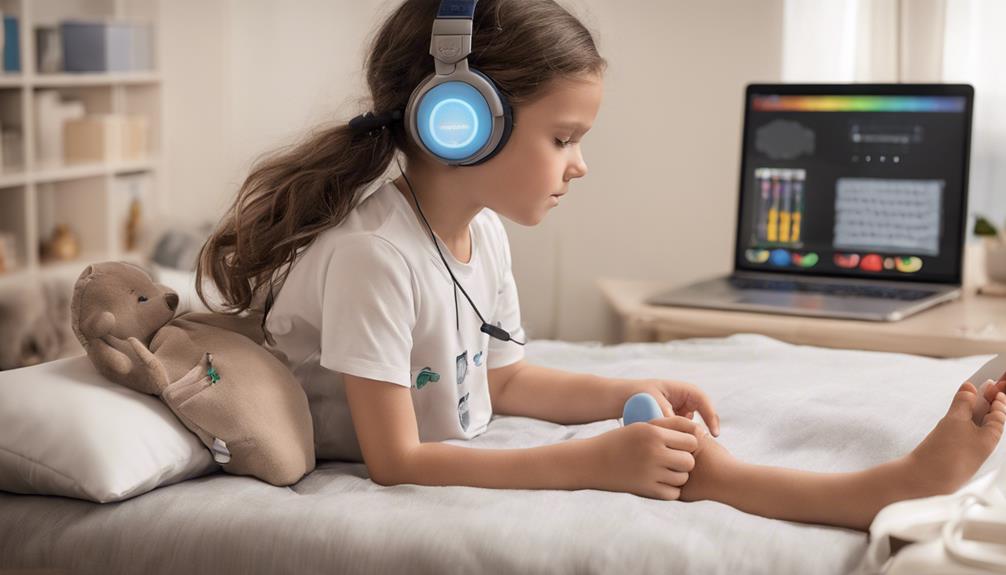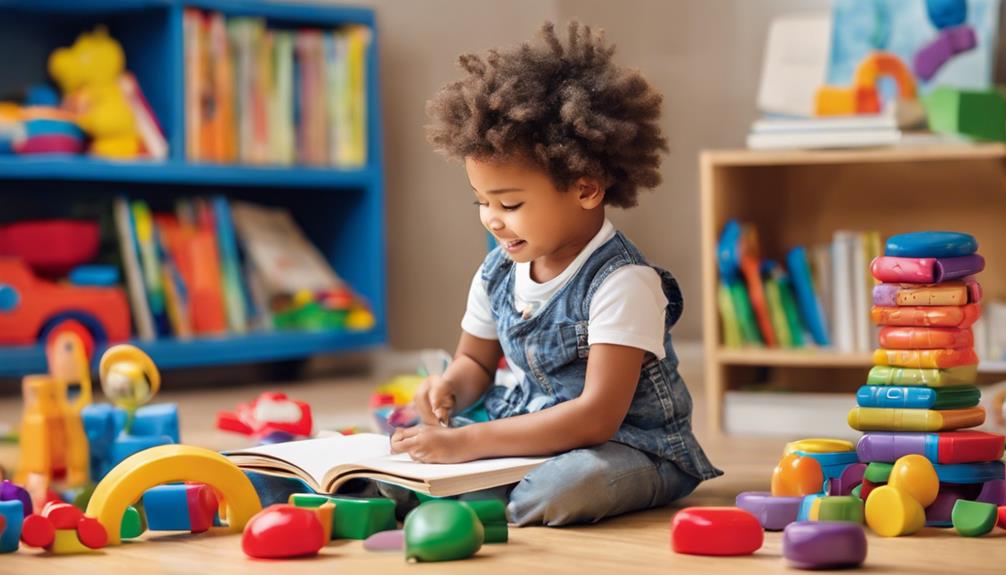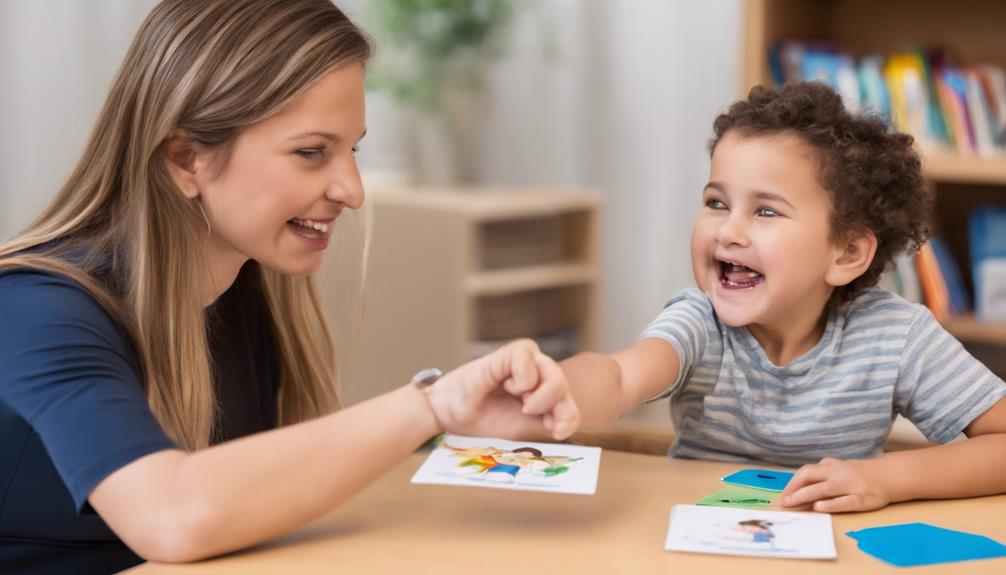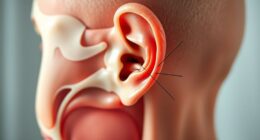When addressing auditory under-responsiveness in occupational therapy, it's like navigating a maze where traditional approaches may not always lead to the desired outcomes.
Delving into specific techniques that cater to individual sensory needs is akin to finding the right key to unlock hidden potential.
By exploring sensory integration activities, targeted interventions, auditory processing strategies, discrimination games, and sensory processing techniques, we aim to shed light on effective practices.
Join us in uncovering how these tailored methods can make a significant impact on enhancing auditory responsiveness and ultimately improving engagement and participation for those we support.
Key Takeaways
- Sensory integration activities enhance auditory responsiveness and modulation.
- Targeted interventions like sensory diets and visual aids aid in managing auditory input.
- Auditory processing strategies improve focus, comprehension, and efficiency.
- Auditory discrimination games and sensory techniques boost attention, memory, and sound interpretation.
Sensory Integration Activities
Sensory integration activities play a crucial role in addressing auditory under-responsiveness by regulating sensory input to enhance processing and response capabilities. Occupational therapists utilize these activities to help individuals with sensory processing challenges develop coping strategies. Deep pressure input, vestibular activities, and proprioceptive input are key components of sensory integration interventions that aim to improve sensory modulation and responsiveness. By engaging in these activities, individuals can effectively process and respond to auditory stimuli, leading to improved attention, focus, and overall sensory regulation.
Occupational therapists carefully select sensory integration activities based on individual needs and sensory profiles to create a tailored intervention plan. These activities provide the necessary sensory input to help individuals with auditory under-responsiveness regulate their responses to auditory stimuli. Through consistent engagement in sensory integration activities, individuals can build tolerance to sensory input, improve their ability to filter out irrelevant stimuli, and enhance their overall auditory processing skills. The structured nature of sensory integration activities promotes adaptive responses to sensory challenges, ultimately supporting individuals in their daily functioning.
Targeted Interventions

To address auditory under-responsiveness effectively, targeted interventions focus on implementing sensory diets, visual aids, structured routines, and auditory discrimination activities. These interventions are tailored to meet the individual's specific needs and promote sensory regulation and auditory processing.
Here are some key strategies that occupational therapists may use:
- Sensory Diets: Customized plans to manage auditory input and enhance attention regulation.
- Visual Aids: Utilizing tools like pictures, charts, and diagrams to supplement auditory information.
- Structured Routines: Establishing predictable schedules and environments to support individuals with auditory challenges.
- Clear Instructions: Providing concise and explicit directions to aid comprehension and task completion.
- Headphones: Allowing the use of headphones for listening to music or white noise to minimize auditory distractions.
These interventions aim to improve auditory attention, memory, and processing skills in individuals with auditory under-responsiveness, enhancing their overall participation and engagement in daily activities.
Auditory Processing Strategies
In addressing auditory under-responsiveness, implementing auditory processing strategies plays a crucial role in enhancing focus, comprehension, and overall auditory input processing efficiency. Occupational therapists utilize various techniques to help individuals who are underresponsive to auditory input. These strategies aim to cater to the sensory needs of individuals with auditory sensitivities, particularly children, by creating an environment that minimizes distractions and maximizes the clarity of auditory information.
One effective approach involves reducing background noise to improve concentration and understanding. Techniques such as using vibration and sound bounce can enhance auditory input processing by making sounds more distinct. Additionally, providing extra time for processing and responding to auditory information can be beneficial for individuals struggling with auditory processing. Integrating visual aids and supports alongside auditory processing strategies can further aid in improving understanding and retention of information. Structured routines and clear instructions also play a significant role in enhancing auditory processing for individuals with under-responsiveness. By combining these strategies, occupational therapists can effectively support individuals in better processing auditory information and improving their overall auditory experiences.
Auditory Discrimination Games

Our selection of auditory discrimination games provides engaging and effective ways to enhance auditory attention, memory, discrimination, and direction-following skills in individuals of all ages. Auditory discrimination games like Red Light, Green Light, Simon Says, Freeze Dance, and Hokey Pokey are specifically designed to improve various auditory processing abilities.
Here are some key points regarding auditory discrimination games:
- These games promote active listening skills
- They help individuals differentiate between various auditory stimuli
- Playing these games can improve auditory processing abilities
- They support better comprehension of verbal instructions
- Activities like Musical Charades, Hot/Cold Listening Game, and I Went to a Picnic Game focus on auditory discrimination, memory, and listening skills improvement.
Incorporating these games into therapy sessions can engage individuals in fun and interactive ways to enhance their auditory skills. By incorporating auditory discrimination games into therapy, individuals can experience a boost in their auditory attention, memory, and ability to follow directions effectively.
Auditory Sensory Processing Techniques
Utilizing structured auditory sensory processing techniques enhances individuals' recognition and interpretation of sounds, aiding in addressing auditory under-responsiveness.
Occupational therapy for children with auditory under-responsiveness involves providing specific auditory sensory input to improve processing abilities. Activities such as auditory discrimination games are designed to enhance attention, memory, and sound interpretation skills.
Therapists may utilize visual aids, clear instructions, and sensory strategies to optimize focus during auditory tasks. By implementing these techniques, individuals can better comprehend and respond to various auditory stimuli, contributing to overall sensory processing improvements.
Occupational therapy plays a crucial role in tailoring interventions to meet the specific needs of each child, fostering a supportive environment for enhancing auditory processing capabilities. Through a combination of structured auditory input and targeted sensory techniques, occupational therapists can help children develop essential auditory processing skills necessary for everyday functioning.
Frequently Asked Questions
How Does Occupational Therapy Help Auditory Processing Disorder?
Occupational therapy helps with auditory processing disorder by improving the brain's ability to process and interpret auditory information. Therapists use techniques such as sensory integration therapy to regulate sensory input and enhance auditory discrimination skills.
Activities like sound discrimination games and auditory processing tasks are utilized to boost auditory abilities. Visual aids, structured routines, and sensory diets further support individuals with auditory sensitivities, creating sensory-friendly environments with tools like noise-canceling headphones.
How Does OT Help With Sound Sensitivity?
When it comes to sound sensitivity, occupational therapy offers a range of techniques that can help individuals better manage their responses to auditory stimuli.
By utilizing methods such as deep pressure touch, heavy work activities, and deep breathing exercises, OTs can assist in calming the nervous system to improve tolerance towards sound.
Tailored sensory diets and gradual exposure to specific sounds are key strategies used to desensitize individuals and enhance responsiveness in various environments.
What Are the Tools to Help Auditory Processing Disorder?
We can support individuals with auditory processing disorders by utilizing tools like:
- Noise-canceling headphones
- Visual aids
- Assistive technology that enhances auditory input
Creating quiet retreat areas and providing sensory tools such as hand fidgets can also aid those with auditory sensitivities.
What Are the Exercises for Auditory Processing?
We've explored various exercises for auditory processing, such as Red Light, Green Light and Simon Says for discrimination skills. Fall Leaf and Musical Bell activities can enhance processing abilities. DIY Rhythm Sticks and Sensory Shaker Bottles are great for discrimination improvement.
Engaging in Musical Charades and the Hot/Cold Listening Game supports memory and listening skills. Recognizing sound differences through rhyming and identifying non-rhyming words can boost auditory processing.
Conclusion
In conclusion, occupational therapy techniques play a vital role in supporting individuals with auditory under-responsiveness.
By incorporating sensory integration activities, targeted interventions, auditory processing strategies, discrimination games, and sensory processing techniques, individuals can improve their ability to process auditory information effectively.
These techniques not only enhance comprehension and participation in daily activities but also create a harmonious symphony of progress and growth in the individual's journey towards sensory integration.











